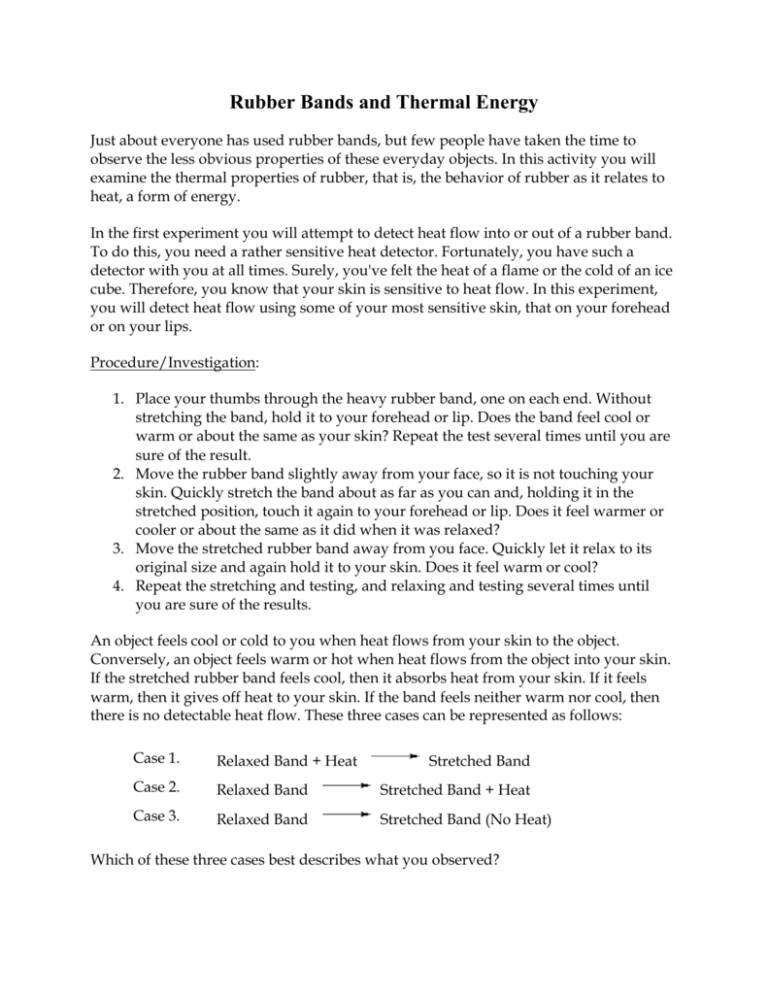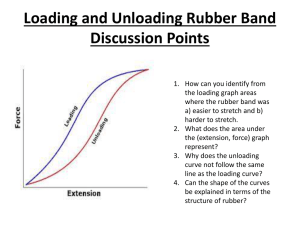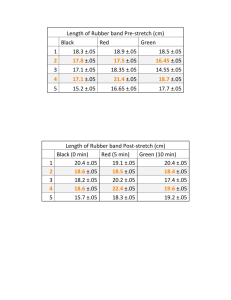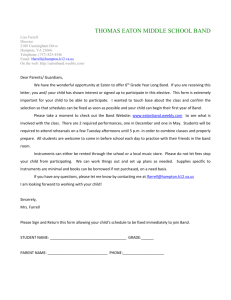Rubber Bands and Thermal Energy
advertisement

Rubber Bands and Thermal Energy Just about everyone has used rubber bands, but few people have taken the time to observe the less obvious properties of these everyday objects. In this activity you will examine the thermal properties of rubber, that is, the behavior of rubber as it relates to heat, a form of energy. In the first experiment you will attempt to detect heat flow into or out of a rubber band. To do this, you need a rather sensitive heat detector. Fortunately, you have such a detector with you at all times. Surely, you've felt the heat of a flame or the cold of an ice cube. Therefore, you know that your skin is sensitive to heat flow. In this experiment, you will detect heat flow using some of your most sensitive skin, that on your forehead or on your lips. Procedure/Investigation: 1. Place your thumbs through the heavy rubber band, one on each end. Without stretching the band, hold it to your forehead or lip. Does the band feel cool or warm or about the same as your skin? Repeat the test several times until you are sure of the result. 2. Move the rubber band slightly away from your face, so it is not touching your skin. Quickly stretch the band about as far as you can and, holding it in the stretched position, touch it again to your forehead or lip. Does it feel warmer or cooler or about the same as it did when it was relaxed? 3. Move the stretched rubber band away from you face. Quickly let it relax to its original size and again hold it to your skin. Does it feel warm or cool? 4. Repeat the stretching and testing, and relaxing and testing several times until you are sure of the results. An object feels cool or cold to you when heat flows from your skin to the object. Conversely, an object feels warm or hot when heat flows from the object into your skin. If the stretched rubber band feels cool, then it absorbs heat from your skin. If it feels warm, then it gives off heat to your skin. If the band feels neither warm nor cool, then there is no detectable heat flow. These three cases can be represented as follows: Case 1. Relaxed Band + Heat Case 2. Relaxed Band Stretched Band + Heat Case 3. Relaxed Band Stretched Band (No Heat) Stretched Band Which of these three cases best describes what you observed? There is another way to test which of the three statements is correct. We can see what happens to the length of a rubber band if we heat or cool it. Procedure/Investigation: 1. Hang one end of the rubber band from the wall or ceiling and suspend a weight from the other end of the rubber band. (What you use for a weight will depend on what is available. The weight should be heavy enough to stretch the rubber band, but not so heavy that it is likely to break the band. For example, hang the band over a door knob and suspend a hammer from the band.) 2. Heat the rubber band with a hair dryer. Start the dryer and, when it has warmed up, turn its heat on the stretched rubber band. Does the stretched rubber band become longer or shorter when it is heated? Does this observation agree with what you found in the first part of the experiment? Doing an experiment several ways and checking for agreement in the results is an important strategy in science. Explanation: When rubber is heated it behaves differently than most familiar materials. Most materials expand when they are heated. Consider the liquid in a thermometer. The thermometer works because the liquid expands when its temperature increases. Similarly, a wire made of metal, such as copper, becomes longer as it gets hotter. The expansion of metals with increasing temperature is the principle behind the functioning of home thermostats and of jumping discs. Whether a material expands or contracts when it is heated can be ascribed to a property of the material called its entropy. The entropy of a material is a measure of the orderliness of the molecules that make up the material. When the molecules are arranged in an ordered fashion, the entropy of the material is low. When the molecules are in a disordered arrangement, the entropy is high. (An ordered arrangement can be thought of as coins in a wrapper, while a disordered one as coins in a tray.) When a material is heated, its entropy increases because the orderliness of its molecules decreases. This occurs because as a material is heated, its molecules move about more energetically. In materials made up of small, compact molecules, e.g., the liquid in a thermometer, as the molecules move about more, they push their neighboring molecules away. Rubber, on the other hand, contains very large, threadlike molecules. When rubber is heated, the sections of the molecules move about more vigorously. In order for one part of the molecule to move more vigorously as it is heated, it must pull its neighboring parts closer. To visualize this, think of a molecule of the stretched rubber band as a piece of string laid out straight on a table. Heating the stretched rubber band causes segments of the molecules to move more vigorously, which can be represented by wiggling the middle of the string back and forth. As the middle of the string moves, the ends of the string get closer together. In a similar fashion, the molecules of rubber become shorter as the rubber is heated, causing the stretched rubber band to contract







